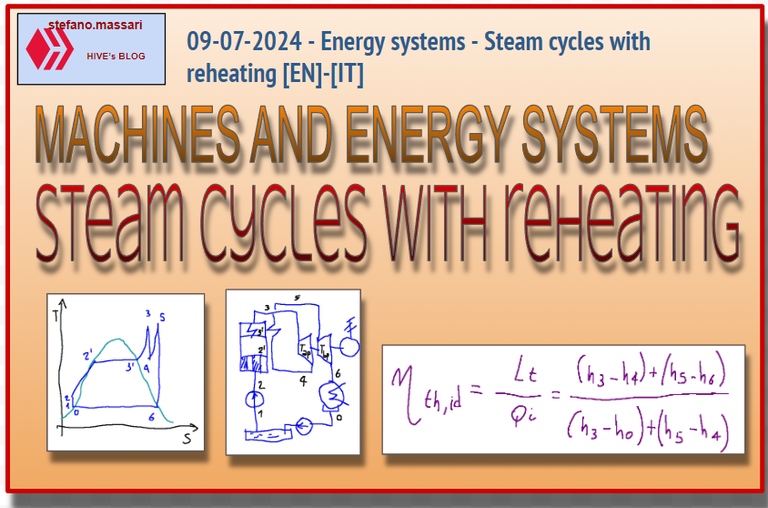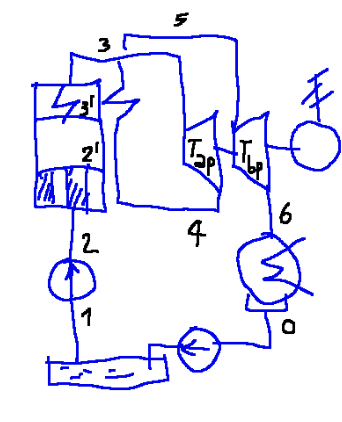09-07-2024 - Energy systems - Steam cycles with reheating [EN]-[IT]

~~~ La versione in italiano inizia subito dopo la versione in inglese ~~~
ENGLISH
09-07-2024 - Energy systems - Steam cycles with reheating [EN]-[IT]
Steam cycles with reheating
Reheating
Steam cycles with reheating are used to improve the efficiency and performance of thermoelectric power plants. Reheating consists of reheating the steam after a partial expansion in the turbine, before it continues the final expansion.
Below is the diagram of the Hirn cycle with reheating on the T-s plane

Below is the system diagram relating to the previous diagram.

Effects of Reheating
It is essential to understand that the possibility of is introduced into the cycle
reheat the steam to overcome the limitation that occurs when the increase in boiler pressure causes a reduction in the steam content
What are the effects of reheating in a steam cycle?
Reheating in a steam cycle has several beneficial effects that help improve the performance and efficiency of the cycle, some of which are listed below:
-Increased Turbine Work
-Improvement of the quality of the exhaust steam
-Increase in the Thermal Efficiency of the Cycle
-Reduction of Erosion and Corrosion Losses
-Greater Operational Flexibility
Thermodynamic efficiency
Below is the expression of the thermodynamic efficiency of the Hirn cycle at real reheating.

Conclusions
Steam cycles with reheating were invented because, for the same energy supplied, it was necessary to develop cycles that were able to increase the energy conversion efficiency.
Request
Have you already heard of thermodynamic cycles where, in addition to overheating, there is also a reheating phase? That is, a further phase of overheating?

ITALIAN
09-07-2024 - Sistemi energetici - Cicli a vapore con risurriscaldamento [EN]-[IT]
Cicli a vapore con risurriscaldamento
Il risurriscaldamento
I cicli a vapore con risurriscaldamento sono utilizzati per migliorare l'efficienza e le prestazioni delle centrali termoelettriche. Il risurriscaldamento consiste nel riscaldare nuovamente il vapore dopo un'espansione parziale nella turbina, prima che esso continui l'espansione finale.
Qui di seguito il diagramma del ciclo di Hirn a risurriscaldamento sul piano T-s

Qui di seguito lo schema dell'impianto relativo al diagramma precedente.

Effetti del risurriscaldamento
Risulta fondamentale capire che si introduce nel ciclo la possibilità di
risurriscaldare il vapore per superare la limitazione che si ha quando con l’aumento della pressione di caldaia si ha una riduzione del titolo di vapore
Quali sono gli effetti del risurriscaldamento in un ciclo a vapore?
Il risurriscaldamento in un ciclo a vapore ha diversi effetti benefici che contribuiscono a migliorare le prestazioni e l'efficienza del ciclo, qui di seguito ne sono elencati alcuni:
-Aumento del Lavoro di Turbina
-Miglioramento della Qualità del Vapore allo Scarico
-Incremento dell'Efficienza Termica del Ciclo
-Riduzione delle Perdite di Erosione e Corrosione
-Maggiore Flessibilità Operativa
Rendimento termodinamico
Qui di seguito l’espressione del rendimento termodinamico del ciclo di Hirn a risurriscaldamento reale.

Conclusioni
I cicli a vapore con risurriscaldamento sono stati inventati perchè a parità di energia fornita era necessario sviluppare cicli che riescono ad aumentare il rendimento di conversione dell’energia.
Domanda
Avevate già sentito parlare di cicli termodinamici dove oltre il surriscaldamento, è presente anche la fase di risurriscaldamento? Cioè un ulteriore fase di surriscaldamento?
THE END
So the reheating phase is the part where it gets extremely hot
Right?
The diagrams are so crazy
It’s a good course regardless
Nice one!
!discovery 30
@tipu curate
Upvoted 👌 (Mana: 0/45) Liquid rewards.
This post was shared and voted inside the discord by the curators team of discovery-it
Join our Community and follow our Curation Trail
Discovery-it is also a Witness, vote for us here
Delegate to us for passive income. Check our 80% fee-back Program
The phase that requires heating will definitely requires a whole lot of energy right